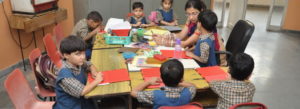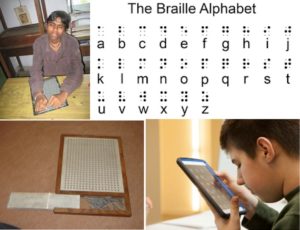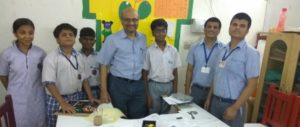Why I quit my Senior Management job at Adobe to work full-time for Blinds?

[ Originally posted in LinkedIn/pulse on October 13, 2018 ]
 The time was early 2014. We had already released Acrobat XI and were working on Acrobat DC. As a Senior Program Manager, one of my roles was to interface with our support team and track all unsolved issues faced by our Acrobat XI users, so that we may fix those in Acrobat DC.
The time was early 2014. We had already released Acrobat XI and were working on Acrobat DC. As a Senior Program Manager, one of my roles was to interface with our support team and track all unsolved issues faced by our Acrobat XI users, so that we may fix those in Acrobat DC.
Initial Spark
During this exercise I came across an unsolved case of a blind user. He was unable to read a PDF document using our Accessibility Reader. On triage I found that the document was a Science Research Paper with lots of calculus and algebraic equations (similar to one below), and the Accessibility Reader was failing to read those portions of the document – marking those as ‘images’. Even OCR (optical character recognition) engine results on such ‘images’ were far from satisfactory. It was evident that we would not be fixing it in Acrobat DC even.

So I decided to talk to the user directly. He was fine even after I told him that we may not be fixing his issue in our next release. But my concern remained – “Then how will you read this document?”
His reply was simple – “I will ask my sighted colleague to read it for me.”
“But this is not an unusual document. Science papers invariably have such formulae and equations.”
He was unperturbed – “I am used to this. Science and blindness don’t gel anyway…”
I was stumped. I could not fathom the fact that a person, who was passionate about learning science, had to be dependent on someone else to pursue his passion. And why did he say that science and blindness don’t gel.
I decided to check and confirm with Blind Schools directly.
The Interactions
Since I was one of the founding members of Adobe’s CSR (corporate social responsibility) arm and was already working with many NGOs in town, it was not difficult for me to get an appointment with one of the most prominent Blind Schools in Delhi.
When I met their Science and Maths teachers, I posed my query to them – “How do you teach Advance Science and Maths to your visually challenged students?”
“We don’t…!” – was their straight-forward reply.
“But why?”, I asked.
“…because we can’t! We don’t have means – the kits, the tools, the teaching aids – to teach them Advance Science and Maths.”
They showed me what all they have got, how they teach the blind students Elementary Maths and Science, how they create, improvise, and innovate the teaching aids all-by-themselves. I was overwhelmed by their dedication and passion, but I was sad for their predicament.

They asked me to meet Mr. J. L. Kaul, the Secretary General of All India Confederation of the Blind (AICB) Delhi, who is the recipient of prestigious Padma Shri Award from Government of India for his initiatives towards Science teaching to the visually challenged students.
The Resolve
When I met Mr. Kaul, I found he is visually challenged himself. I was impressed by the way he was discharging his duties with full conviction and confidence.
Mr. Kaul told me that there do exist tools, aids, and kits to teach Advance Science and Maths, but these either are too basic, too expensive, not easily available to be of much use at such a large scale, or are computer and mobile based – thus are too expensive for common students, in addition to being unsuitable for the early stage learning.

“Technological advancements and high technical brains have sidestepped the needs of the common blind people.” he bemoaned.
“What I need is technological help from persons like you, not your funds.”, he appealed to me, “Can you spare me a tiny bit of your time, your skills, and your knowledge? Can you develop technology – a low cost, scalable technology – so that my students can learn Science and Maths till Class X level at least (Secondary school level in India)?”
I was sitting there speechless, a lot ashamed of myself. It is pertinent for me to use my brain for giving back to the society, and as an I.I.T. graduate I could surely make a lot of difference on technology front too.
I sat there for a long time… Then I decided to make amends.
That moment itself, I made a resolve that I would work to ensure that the blind students are able to do Science and Maths till Secondary School level – and that would be my post-retirement goal.
I purchased one set of all the existing tools, aids, and kits from the AICB store. I needed those to get the idea what was the starting point of my journey.
The Decision
I decided to put my weekends to this cause. But as time passed and Acrobat DC release deadline came nearer, I found that my job was not letting me with any spare time. By early 2015, I had become desperate. It was clear that I had to choose between the two – my job or my resolve. It was clear that till I am on my high-profile job, I won’t be able to do justice to my resolve – and vice versa.
But I was not willing to go back on my resolve that had become my life goal by now.
By March 2015, I made up my mind to take an early retirement from my Senior Management job at Adobe as soon as Acrobat DC gets released in April 2015.
Eventually, in August 2015, I was out of Adobe – free to pursue my new life goal full-time – viz. to work towards ensuring that the visually challenged students are able to learn Maths and Science till Secondary School level and beyond.
Believe me… I haven’t regretted my decision a bit !


Leave a Reply